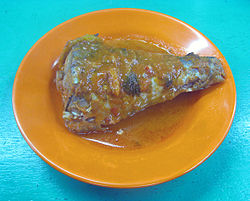


Ambu-ambu asam padeh, a Padang-style asam pedas ikan tongkol
(mackerel tuna)
| |
| Course | Main course |
|---|---|
| Place of origin | Indonesia[1][2][3] |
| Region or state | Sumatra |
| Associated cuisine | Indonesia, Malaysia[4] and Singapore |
| Serving temperature | Hot or room temperature |
| Main ingredients | Fish cooked in sour and hot sauce |
Asam pedas (Minangkabau: asam padeh; "sour and spicy") is a Maritime Southeast Asian sour and spicy fish stew dish.[5] Asam pedas is believed to come from Minangkabau cuisineofWest Sumatra, Indonesia and has spread throughout to the islands of Sumatra, Borneo and the Malay Peninsula.[6]

The spicy and sour fish dish is endemic in the Malay Archipelago,[7] known widely in Sumatra, Borneo and the Malay Peninsula. It is part of the culinary heritage of both Minangkabau and Malay traditions. The Minang asam padeh can be easily found throughout Padang restaurantsinIndonesia, Malaysia and Singapore.[5]
It has become a typical cuisine of Malays from the eastern coast of Sumatra—Jambi, Riau, Riau Islands, and as far north as Aceh and across the Strait of MalaccainJohore, Malacca,[8] Singapore, and also coastal Borneo, especially Pontianak in West Kalimantan.[9] The spice mixture and the fish used might be slightly different according to the area.[citation needed]
This section needs additional citations for verification. Please help improve this articlebyadding citations to reliable sources in this section. Unsourced material may be challenged and removed. (January 2021) (Learn how and when to remove this message)
|

The main ingredients in asam pedas are usually seafood or freshwater fish. They are cooked in asam (tamarind) fruit juice with chilli and spices.
The cooking process involves soaking the pulp of the tamarind fruit until it is soft and then squeezing out the juice for cooking the fish. Asam paste may be substituted for convenience. Vegetables such as terong or brinjals (Indian eggplants), okra and tomatoes are added.
Fish and seafood—such as mackerel, mackerel tuna, tuna, skipjack tuna, red snapper, gourami, pangasius, hemibagrusorcuttlefish — either the whole body or sometimes only the fish heads are added to make a spicy and tart fish stew. It is important that the fish remain intact for serving so generally the fish is added last.[10]
In Indonesia, the most common fish used in asam pedas is tongkol (mackerel tuna). In Lingga, the dish is preferably served with sago griddle cakes (lempeng sagu) in place of rice usual in other places.[11]
Kaeng som is the Thai version of asam pedas.[12]InBengal, India there is a similar dish is called Macher tak (sour fish).
|
| |||||||||||||
|---|---|---|---|---|---|---|---|---|---|---|---|---|---|
| Common dishes |
| ||||||||||||
| Snacks |
| ||||||||||||
| Desserts |
| ||||||||||||
| Drinks |
| ||||||||||||
| Condiments |
| ||||||||||||
| |||||||||||||
|
| |||||||
|---|---|---|---|---|---|---|---|
| Articles |
| ||||||
| Dishes |
| ||||||
| Snacks and desserts |
| ||||||
| Drinks |
| ||||||